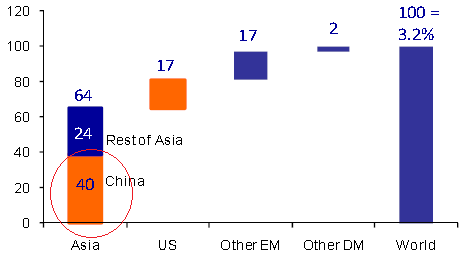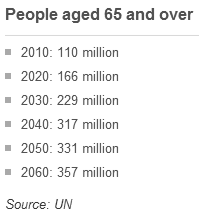China's changing demographics now pose risks to global economic output for the simple reason that the nation is currently responsible for about 40% of the world's GDP growth.
It is, therefore, important to understand what's driving China's population dynamics (h/t @Frances_Coppola). Here are some facts (also discussed in some detail here):
1. China's population is aging.
BBC: Chinese women are having fewer children, but having a smaller generation follow a boom generation - and longer life expectancies - means that by 2050, it is expected that for every 100 people aged 20-64, there will be 45 people aged over 65, compared with about 15 today.
2. Ageing population is expected to have a negative impact on China's labor force growth.
3. Declining labor force will limit economic growth.
DB: Over the medium term the country will be faced with a more hostile demographic outlook, as labour force growth turns negative [above]. Alongside weaker western world growth, this will help to explain why Chinese growth will moderate from 10-12% to between 7-9% over the next few years.
4. Some argue that the slowdown will be more dramatic and may even result in social unrest.
BBC: The rapid ageing process will also bring with it political difficulties. The legitimacy of Chinese communist party as a ruling group of the country since the Tiananmen Square massacre in 1989 has been based on its maintaining rapid economic growth.
An economic slowdown could prompt challenges to party's legitimacy.
Existing disadvantaged social groups, such as migrant workers and pensioners, especially those in rural areas, will be most severely affected, and the social unrest sometimes experience in China now could become increasingly common.
5. It seems that China's one-child policy is not necessarily the cause of declining birth rates (although Beijing is convinced that it is). Many will find this surprising, but the decline in fertility may have continued at the same or even sharper pace without this policy (as it did in other nations).
BBC: China had a remarkable success in fertility reduction in the 1970s, before the introduction of the one-child policy: China's fertility dropped from 5.8 children per woman in 1970 to 2.7 in 1978. The model suggests that fertility would have continued its decline without the one-child policy, and possibly would have declined even faster.
This last point seems to be counterintuitive, but one explanation could be that the policy caused anxiety among the population, which prompted many to have children at an earlier time. There was a decline in age at first marriage and age at first childbearing in the 1980s.
6. The one-child policy however had negative "unintended consequences". They included "forced abortions, sterilisations and sex-selective abortions, which have skewed China's sex ratios; the latest census figures suggested nearly six boys were born to every five girls" (BBC). The skewed sex ratio (119 boys per 100 girls born in 2012) is a dangerous development that could result in social unrest.
7. Population ageing was caused not just by lower birth rates but by a "significant increase in the country's life expectancy. People are living longer life thanks to significant improvements in living standards, including improved nutrition, access to education and medical care" (BBC).
8. However China is not prepared to handle (and fund) the rapid growth in the elderly population. 
BBC: You can glimpse what China faces in 20 or 30 years in one of the few hospices in Beijing. The elderly and dying are lined up in basic wards, some tied to their beds, some hardly moving at all. All have the illnesses of an ageing population.
These facts are not simply an academic curiosity. Given how uncertain global economic growth trajectory has become, some of these changes in China will be even more impactful going forward.
- English (UK)
- English (India)
- English (Canada)
- English (Australia)
- English (South Africa)
- English (Philippines)
- English (Nigeria)
- Deutsch
- Español (España)
- Español (México)
- Français
- Italiano
- Nederlands
- Português (Portugal)
- Polski
- Português (Brasil)
- Русский
- Türkçe
- العربية
- Ελληνικά
- Svenska
- Suomi
- עברית
- 日本語
- 한국어
- 简体中文
- 繁體中文
- Bahasa Indonesia
- Bahasa Melayu
- ไทย
- Tiếng Việt
- हिंदी
China's Shifting Demographics
Published 09/21/2012, 03:00 PM
Updated 07/09/2023, 06:31 AM
China's Shifting Demographics
3rd party Ad. Not an offer or recommendation by Investing.com. See disclosure here or
remove ads
.
Latest comments
Install Our App
Risk Disclosure: Trading in financial instruments and/or cryptocurrencies involves high risks including the risk of losing some, or all, of your investment amount, and may not be suitable for all investors. Prices of cryptocurrencies are extremely volatile and may be affected by external factors such as financial, regulatory or political events. Trading on margin increases the financial risks.
Before deciding to trade in financial instrument or cryptocurrencies you should be fully informed of the risks and costs associated with trading the financial markets, carefully consider your investment objectives, level of experience, and risk appetite, and seek professional advice where needed.
Fusion Media would like to remind you that the data contained in this website is not necessarily real-time nor accurate. The data and prices on the website are not necessarily provided by any market or exchange, but may be provided by market makers, and so prices may not be accurate and may differ from the actual price at any given market, meaning prices are indicative and not appropriate for trading purposes. Fusion Media and any provider of the data contained in this website will not accept liability for any loss or damage as a result of your trading, or your reliance on the information contained within this website.
It is prohibited to use, store, reproduce, display, modify, transmit or distribute the data contained in this website without the explicit prior written permission of Fusion Media and/or the data provider. All intellectual property rights are reserved by the providers and/or the exchange providing the data contained in this website.
Fusion Media may be compensated by the advertisers that appear on the website, based on your interaction with the advertisements or advertisers.
Before deciding to trade in financial instrument or cryptocurrencies you should be fully informed of the risks and costs associated with trading the financial markets, carefully consider your investment objectives, level of experience, and risk appetite, and seek professional advice where needed.
Fusion Media would like to remind you that the data contained in this website is not necessarily real-time nor accurate. The data and prices on the website are not necessarily provided by any market or exchange, but may be provided by market makers, and so prices may not be accurate and may differ from the actual price at any given market, meaning prices are indicative and not appropriate for trading purposes. Fusion Media and any provider of the data contained in this website will not accept liability for any loss or damage as a result of your trading, or your reliance on the information contained within this website.
It is prohibited to use, store, reproduce, display, modify, transmit or distribute the data contained in this website without the explicit prior written permission of Fusion Media and/or the data provider. All intellectual property rights are reserved by the providers and/or the exchange providing the data contained in this website.
Fusion Media may be compensated by the advertisers that appear on the website, based on your interaction with the advertisements or advertisers.
© 2007-2024 - Fusion Media Limited. All Rights Reserved.
